 01392 914033
Offices are currently closed
01392 914033
Offices are currently closed
You’ve spent time researching, crafting and perfecting a great new blog post, congratulations, you’re now just half the way to sharing your ideas and expertise with the world! But what are the next steps you should take to get more blog traffic in 2016?
Did you know a recent study at the end of 2015 proved that 50% of online content gets as little as 8 shares or less? A shocking revelation. But have you stopped to think how many hits your last blog received? Head over to analytics now and find out, as if the result is not what you hoped theres plenty you could do for the next one.
Warning!!! Publishing a blog on your website in 2016 without promoting will be an absolute waste of your time.
Your focus moving forward is to share it with the world! Or at least with people who will benefit and enjoy and hopefully share it also. But wait… are you not feeling confident that your article doesn’t quite cut the mustard? Make sure you have it checked by someone else as you won’t get a second chance with that first impression.
[bctt tweet=”73% of content creators plan to prioritize creating more engaging content in 2016, and 55% plan to prioritize creating visual content.”] Source
Good to go? OK, here’s the exact process you should use to get more blog traffic in 2016…
Before you publish the article you will want to carry out a little research and make a plan. First and foremost you’ll want to understand the people who are likely to enjoy and share your article. For example, great infographics that strike a chord (interests) like this one on Exeter Facts (people living and visiting Exeter) and articles like this one (those who work in online marketing and website owners who are looking to improve website trust and conversions) were both content pieces that were targeted at audiences likely to share.
There are 3 different types of internet user; those who you are interested in your article and who would benefit and enjoy reading (75%); those who have active multiple social media accounts and who create and curate similar kinds of content to their audiences (20%); and those who are BIG content sharers and who usually run their own blog or website (5%).
You will increase your chances of receiving more traffic to your article if you target the 25% of your interested audience. There’s no harm in targeting the 75% if that’s who your blog is targeted to but can have much less effect.
“The more unique and relevant the article, the more likely influencers will be to share it”
Using a spreadsheet like this one, create a list of sites that your target audiences hang out on. Then create a new bookmark folder in 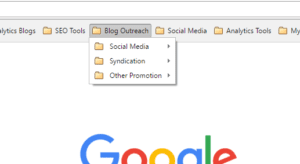 your browser labelled “Blog Outreach”.
your browser labelled “Blog Outreach”.
Bookmark each of the website pages on the list from the spreadsheet, making sure you have created an account before-hand. Then you will have easy access to each page, when it comes to promoting your blog. This will save you time and make article promotion easier.
There are a range of tools available to identify those 25% who are more likely to engage and share your article. I like Buzzsumo the most as it provides you with this information and guides you how to use it better than any other platform. Headover there and sign up for a free trial account or you can try out the new influencer tool here.
On Buzzsumo you can also search for articles similar to yours and find out who shared them. Then you can save these influencers to outreach lists, view and respond to their newest content and most relevant conversations which will increase the chances of them sharing yours. You can now also search their tweets by hashtags or keywords.
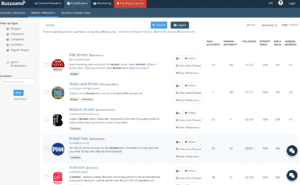
Using Moz’s open site explorer will also allow you to discover who has shared similar articles than yours. If you have created an article better than others available, why not contact the websites that are linking to it and ‘point out’ that there’s a newer, better version available online which their readers could enjoy more?
When it comes to finding content sharers who are interested in the topic of my blog, I use a fantastic tool called Followerwonk. This free to use tool allows you to type in a keyword and a location (if needed) and scrape Twitter profiles. You will be then gifted with a list of people relevant to that keyword (and location) so you can connect with them. I always create a hidden list in Twitter and add the best ones on there for future use.
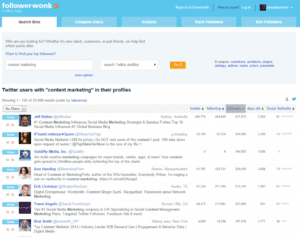
I see Jeff Bullas is at the stop of the “content marketing” social stack, so I am going to…
You’ve Forgotten Your #Blogging – 7 Bad Signals It Sends To Your Customers!!! https://t.co/YH3BbWEdDt #bloggingtips #contentmarketing
— Jeff Bullas (@jeffbullas) January 24, 2016
So how can you find out where your wider audience hang out online? The chances are you’ll already know which Facebook groups, blogs, Google + communities etc they use. If not, use the spreadsheet I gave you earlier and start searching each platform. To find out your larger target audience try using Google’s display planner. Simply add in a few of your target audiences interests and the URL to your website, you’ll have a list of blogs and websites you can target in no time.
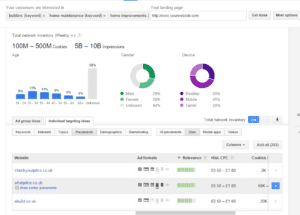
Make a list of the best communities where your readers are gathering and start participating in the conversation. You don’t need to spend very long doing this, but a few carefully thought out comments can go a long way to connecting with your audience. Then when it comes to sharing your blog article in this circle, the chances of it being accepted, re-shared and commented on will dramatically increase. Don’t appear to be a spammer or suffer the consequences!
There are a few industries and topics with a low influencer and audience type such as funerals or some B2B software for example. Don’t fear, a tweak in the content you create is key to the success of your content marketing strategy. You don’t want to create boring content – fact. So researching into your customer and audiences needs is essential. Answering their questions is probably the most effective content marketing strategy around, be sure to execute it better than any of your competitors though otherwise it’s time wasted. Create engaging content targeted at similar interests to your audience, like the Exeter Facts I mentioned earlier.
Until you press the publish button on your article, or even after, it’s never too late to make changes. If by now you’re thinking that your article isn’t very good and holds little value for anyone, then re-write or scrap it and start again. You should never write an article for the sake of wring for SEO purposes anymore, those days have gone. Write only if you are helping others in some way.
[bctt tweet=”The key to success with blogging is simple… Help others”]
How far that little candle throws his beams!
So shines a good deed in a weary world.
– William Shakespeare
By now you will have a better understanding of who your target audience is and what they enjoy reading and sharing. You can use this new found knowledge to help when publishing your blog.
>>Use this checklist for an amazing article
Include embedded tweets – if relevant to your content including an embedded influencers tweet in your post will increase the trust readers will have, the engagement and also the chance that this influencer will also share the article with their audience. Mentioning other useful blog resources or websites will also increase user engagement and will be an opportunity for gaining new traffic as these bloggers may share your article.
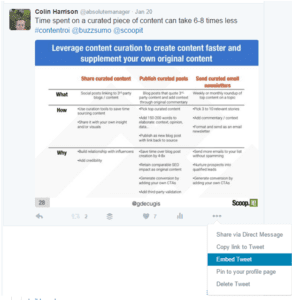
Using the spreadsheet and bookmark list you created, it’s now time to start promoting your blog post to each of your audiences.
Sharing your post on each of the social networks will drive more traffic to your blog post. Work your way down the list of platforms, groups and communities and share snippets of what your content is about. Make sure you write an engaging title and add a great picture, this alone can increase clicks by over 83%.
[bctt tweet=”Visual content is more than 40X more likely to get shared on social media than other types of content.”] Source
You should start by posting your blog article on the following platforms
Great news to all social media users is now you can turbo boost all your social sharing. So every time you share a piece of content, from anywhere on the internet, you can add your very own call to action in the footer. Head over to http://snip.ly/ and sign up for a free account. Using their browser extension you can share any other piece of content you like! If you use a content sharing platform like Buffer or Hootsuite then you can also integrate it with them.
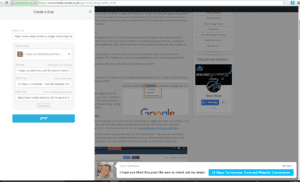
Content sydication is powerful when done right. It is the process of pushing your blog and site content out into third-party sites, either as a full article, snippet, link, or thumbnail. To avoid duplicate content do not republish the full article until you are sure it is done correctly. Here are some of my personal favorite syndication, Q&A and sharing platforms. However it’s reccommended you carry out some research into the ones that work best for you.
Repurposing your article into different forms can really boost the amount of traffic to your blog. This is done by using the key elements (or learning points) of your article and putting them in a different format i.e. video, slideshow or podcast. It might take a little time to become familiar with each platform but once you’ve tried it a few times it will become second nature.
 Reviewing the success of your blog is something many don’t bother to do. But you’ll be missing out on a whole range of valuable information if you don’t also. Be sure that your website has analytics properly set up on it you will be able to identify which platforms have driven the best quality traffic and which of your key influencers has helped in the process. Be sure to use this information to shape your future content marketing outreach strategies, saving time and effort.
Reviewing the success of your blog is something many don’t bother to do. But you’ll be missing out on a whole range of valuable information if you don’t also. Be sure that your website has analytics properly set up on it you will be able to identify which platforms have driven the best quality traffic and which of your key influencers has helped in the process. Be sure to use this information to shape your future content marketing outreach strategies, saving time and effort.
If you have written a great article and you follow these steps to promote it, there is no reason why it won’t drive more traffic to your website. Keep on trying and be consistent! All the best and happy blogging! Your feedback is welcome in the comments below.